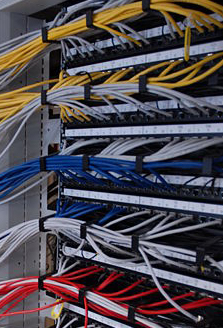If you own or manage two or more computers you need to connect your computers in a wired network to share Internet Connection and other services.
Here is a complete How To Build a Network.
Whether you are doing it at home or at your workplace, creating a computer network is not very difficult if you are a handy person and you have basic knowledge of computer networks. We will cover here most of the concepts you need to make your own LAN.
The series of articles will show you how to create a physical network and how to configure it to provide various services to your network users. We will focus on TCP/IP networks as this is the most common networking protocol.
Why Do You Need a Network?
You need a network if you need to share services for two or more computers.
Services that can be shared include: File sharing, sharing a network printer, Internet sharing, email services, Intranet, media broadcasting, etc…
In a home network, it is very common to share a printer and the Internet Connection.
In Business environment, the network becomes more complex and many more services will be needed to accommodate the use of many computers in a single network. Such services are DHCP – for automatic IP configuration, DNS – for name to IP resolution, corporate email, Proxy Server – for increased security on Internet, Intranet server – this is a private web server, VOIP phone system, etc…
What are the Limitations of My Network
You Ethernet cables are limited to 100m between any two active devices. If you need more than 100m between any two active devices such as computer and switch or computer to computer, you need to add a repeater or a hub, a switch will work as well, at each additional 100 meters, (or 333 ft.).
Depending on your materials and equipment, your network can run at 10Mb/s, 100Mb/s or 1Gigabit/s.
The most usual is to use Cat 5 or Cat 5e cables and connectors. A Cat 5 network can provide a speed up to 1000Mb/s.
If you need to connect at longer distances the more suitable solution are
Coaxial cable – up to 500M, speed 10Mb. You need special repeaters or hubs or special network cards.
The fiber optic – 10Km or more, speed up to 100Gb, depending on the equipment. It is the most expensive solution; the price though can be affordable for slower connections. For slower connections, most of the cost will consist on running the cable between the two points.
DSL is the cheap way to connect two remote offices if you have an available copper pair between the two offices.
What Do I Need to Make My own Network?
To make your own Ethernet Network you need the following equipment:
UTP/STP networking cable, RJ-45 connectors, Crimping tool, Punch down tool, Keystone Jacks, Wire stripper / Knife, Network Tester, Patch Panel, Network Switching device. The list includes also a stud finder, drywall saw, measuring tape, mounting plate, fish tape, ladder, and the usual tools such as screwdriver, drilling machine, hammer, etc…
Ample descriptions on the tools and materials are provided by following the links.
Computer Network Planning
The typical Ethernet Network has a star topology. That means that you have a central device, (network switch), that connects all of your network participants. This is important for your planning since you will have to run all of your cables to a central point. Make your measurements and place your central point in such manner that all of your cables are 100m or less. This includes the patch-cord as well.
If you have computers farther than 100m you will need to install a repeater. Alternatively you can use other types of connection, (coax, fiber optic, etc…), see the limitation paragraph.
When you run a cable consider the maximum amount of devices that can be stuffed into that office. It is a lot cheaper to run an extra cable or two per each office location than to run a single cable after the initial installation.
Install the keystones as close as possible to the actual location of the computer. Plan this thoroughly and pick the best location so that the patch-cord is out of the way.
Buy extra cable and extra connectors.
Use common paths for your cables whenever possible. If you run ten cables at once saves a lot of work and time.
Plan your cable route. Use ceiling whenever possible, it is the easiest path. Avoid running the cables near big electromagnetic sources.
Buying Computer Network Tools and Supplies
Do not buy cheap tools and materials. If you do, you will be penalized in different ways:
At the installation time you will get all sorts of problems trying to connect poor materials, cheap cable will be damaged more easily when manipulated, connectors will break easier.
In time the quality of the network will decrease if poor supplies and tools are used.
Overall experience and quality will be very poor if you get too cheap. If buying expensive tools is not justified, (a one time job), try to borrow good tools and don’t buy cheap ones.
Follow the links to learn what to look for when you are buying specific materials.
Now that you planned and bought all the Networking tools and supplies you can proceed to the Running the Cables for a Computer Network.